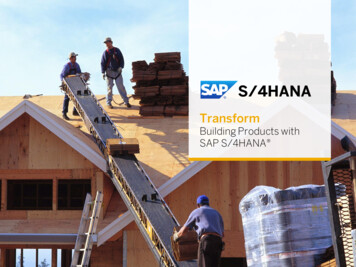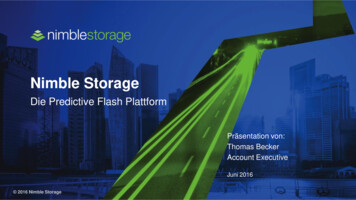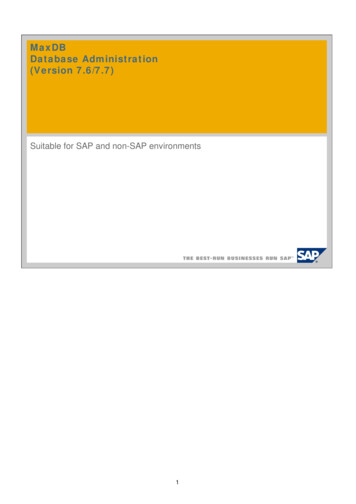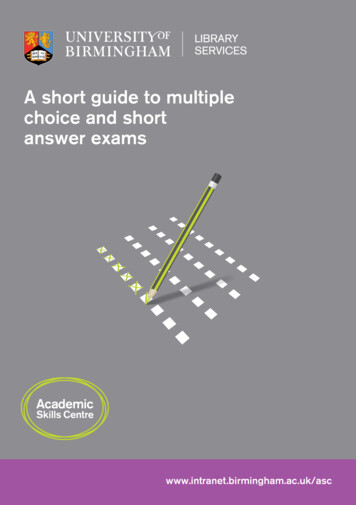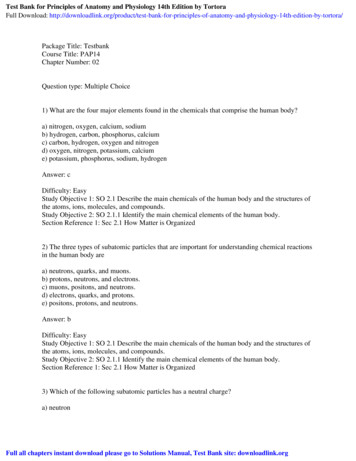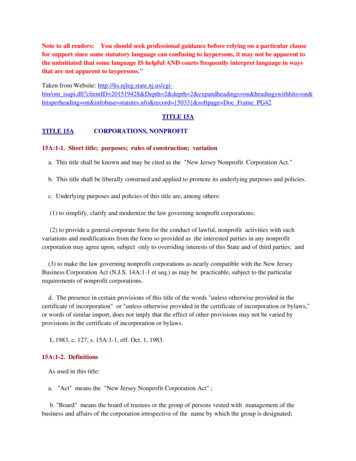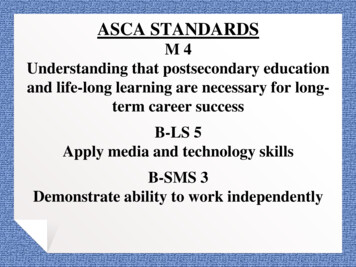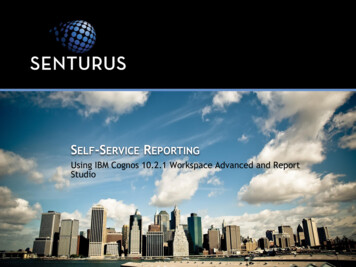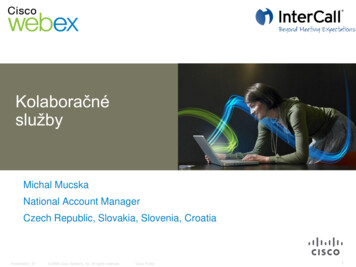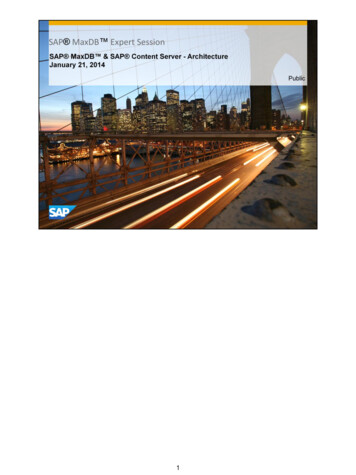
Transcription
1
2
3
4
The central task of the Knowledge Provider is the handling of all kind ofdocuments within the frame of the SAP R/3 system.But as the focus of our Expert Session is on the place of SAP MaxDB databasein the SAP Content Server we concentrates more on the Content ManagementService branch with the SAP MaxDB as one of the storage system and theinterfaces between Knowledge Provider and Content Server, and ContentServer and the database as storage system.5
There are listed three KPro services: Document Management Framework(DMF), Document Management Service (DMS) and Content ManagementService (CMS). The two first are using the Document Modeling Workbench(DMWB) as a tool for maintaining document administration models. TheContent Management Service functions are an interface between contentservers and the SAP system for adding, handling and deleting all kind ofdocuments.SAP CRM - SAP Customer Relationship ManagementSAP PLM - SAP Customer Relationship ManagementADK - Archive Development Kit6
It is the Content Management Service which connects the R/3 system with theContent/Cache Servers and provides the smooth handling of the documentsstored in the SAP MaxDB from all involved SAP applications.7
If an application can use Kpro interface it can be integrated in the KnowledgeProvider and uses its offered services.8
Document Management Service can create content models with differentdocument types like text, graphic, video sequences, websites which can havedifferent list of characteristics like format, author, ‘last changed by’, languageand others.The Content Server is using the CMS functions. Some of them can support thecustomer by checking the database content as for example docGet.An example and explanation you’ll find later in this presentation.9
The Content Server will be handled in detail in the next section.10
11
The CMS functions are also used by the Content Server Engine.The MaxDB software is delivered with every Content Server installation as ofSAP Content Server Version 4.6. The Content Server configuration fileContentServer.INI or cs.conf is in the content server installation directory. Thecontent of this file is described in the SAP note 329473 “Description of the fileContentServer.INI”The database components are supported by SAP MaxDB team.12
You can use all SAP application which have an KPro interface to passdocuments to one Knowledge Provider.The Knowledge Provider communicates via RFC and SAPHTTP interface withone or several Content/Cache Servers.Any Content Server communicate with one or several storage hosts. One orseveral Databases and/or File Systems can be used at the same time for oneContent Server. But also one Database can contain data of several ContentServers.13
One database can contain several repositories but one repository can never bedistributed to two databases or to another storage hosts. A repository containsthe list of all documents and the documents itself which are stored in therepository.It is recommended to have different repositories for ease of administration. Thetroubleshooting from application side (KPRO) would be easier when there is arepository for each document class and there will be a segregation ofdocuments based on different applications. Based on the repository name atthe content server level, we can also narrow down the applications which areusing this repository.A document can have different components e.g. pdf, png, doc, gif . We aretalking about the storage layer later in this session.14
Most advantages of the SAP Content Server is caused by the fact that adatabase is used as the storage layer. SAP only supports SAP MaxDB as acontent server database.15
The Cache Server installation is by default offered within the Content Serverinstallation. The database CDB can also created to the same time. The CacheServer is used often in the geographically wide distributed customerenvironment with highly frequent document access.It is better to install one or several Cache Server after the detailed analysis ofthe productive use of the Content Server.16
Please be really aware that the log writing is by default disabled in the CacheServer database. We will talk about this in detail later in this session.You will be pointed to the risk if the Cache Server will be by mistake used asContent Server and huge amount of the documents will be changed on theCache Server and not as recommended on the original Content Server.17
The HTTP-client is the part of the Cache Server which differs it to the ContentServer.18
19
By calling the administration transaction CSADMIN the concrete contentrepository from the list of all existing repositories in this Content Server or theconcrete server which contains a needed repository in the file system or in thedatabase should be chosen.The transaction CSADMIN doesn’t contain any information about the SAPMaxDB database which can contain the concerned repository.20
In the Details tab the Content Server version and build are shown together withthe status of this content repository. If the database is in the offline status, therepository will also have the offline status.21
The Certificates tab lists the existing security sertificates.22
The repository setting shows the name of the database server, the name of theContent Server database, the name of the used ODBC driver on the databaseserver and another settings.In the Settings tab the ODBC trace should be activated with the optionSQLTrace 1 for the Content Server on UNIX/Linux servers.23
The Statistics tab shows the partial result of the connection test to the ContentServer which can be run completely with the test program RSCMSTHS. Thecalling of this test program is described in the next slides.24
All new repositories are created in the CSADMIN transaction. At least the nameof the database server, the name of the database, the repository name and therepository description should be entried into the settings.25
In transaction SE38 several important CS related reports can be run forchecking different sides of the Knowledge Provider and Content Server.So we can start the SAPHTTP check report RSHTTP05.26
The SAPHTTP check checks all RFC destinations which are used in thecommunication between Knowledge Provider and Content Server.If an error occurs here the database is not involved yet. These kind of errorshave to be analyzed by the KPRO or Content Server (application) colleagues.27
After calling report RSCMST via transaction SE38 the concrete repository ischosen. This report collects the total range of Content Management Service(CMS) check programs and all of them are running for one concrete repository.28
After the report RSCMST has been executed you’ll get the following list ofpossible checks.We are talking now about the RSCMSTHS check only. The test programRSCMSTHS is checking the HTTP connection to the Content Server usingthe data of one concrete data repository.By choosing different repositories the connections to different Content Serverscan be checked.29
Now we are talking about the results of the check.The RSCMSTHS test results show the repository name and description, theContent Server version and build.Also you have a chance to see if there is any time difference between the SAPsystem and Content Server. This you must take into consideration if you checkany traces.30
The last test result section of the RSCMSTHS test program shows details tothe connection test: the average, minimum and maximum response time inmilliseconds, the size of the data send to the Content Server, the amount of testrequests.The requests are handling the general R/3-client-server communication withoutthe connection through the ODBC driver to the database.31
DocID is an system-wide unique identifier for document header assigned bythe Knowledge Provider.The report RSHTTP52 can check if a document exists (used by support peoplein error situation). If the report results with d’document not found’ additonalchecks are necessary. How we check if a document really exists or not ondatabase level will be handled later in this session.The report runs the function docGet of the Content Server HTTP Interface. Atthe same time you can check with this report one single document, if thecontent repository which contains it and the concrete DocID is known.32
The results of the report is the direct output of the HTTP function docGetwithout any additional handling that‘s why the response header contains theinformation needed for the connection to the right repository: database servername, communication port, the repository name, document id and furtherretrieved information about the time stamp of the document, its length, classand status.33
The report delivers also the full content of the document extracted from thecorresponding COMPONENTS* table.34
35
For nearly all aspects in connection with the MaxDB ODBC driver the mostimportant information is whether Content Server is running on Windows orUNIX/Linux.This is the first point which should be taken into the consideration when forexample a problem situation with the Content Server or/and storage hostshould be analyzed.36
The usage of SAP MaxDB database as storage host for the Content Serverwas initially developed for the use on Windows. The request for a document issent as an URL with the SAPHTTP interface to the Content Server whichtransfers it to the Microsoft IIS Server. After passing the IIS Server the requestarrives the ODBC driver which handles the information and provide it to theMaxDB database kernel.37
On the database server several versions of the database software can beinstalled. Also several ODBC drivers with different database versions andnames can be registered on the database server.It makes sense to register only one ODBC driver which should be used by theContent Server and another application and delete multiple driver registration.If the ODBC trace is taken from the Windows OS side it is important to use theOS user which is used by default for the Content Server and storage hostcommunication line.38
See SAP note 1571193 Using MaxDB Versions 7.7 & 7.8 in the content serversystem39
The usage of SAP MaxDB database as storage host for the Content Serverwas developed for the UNIX/Linux operating systems additionaly. The requestfor a document is sent as an URL with the SAPHTTP interface to the ContentServer which transfers it to the Apachi Webserver. After passing the ApachiWebserver the request arrives the ODBC driver. The driver is statically linkedin this case into the Content Server software as shared library which handlesthe information and provide it to the MaxDB database kernel.40
It is important to keep in mind that on UNIX/Linux the ODBC driver is the part ofthe Content Server installation as the statically linked shared library that‘s why itcan‘t be changed or used with the database tools and/or database installation.The Content Server configuration file is cs.conf on UNIX/Linux andContentServer.INI on Windows. It describes the setting up of the repositoriesthat can be addressed from the content server. The configuration file MUST bein the content server installation directory.The file is usually kept up-to-date automatically by the content server, therefore,manual editing is not required. Transaction CSADMIN exists for themaintenance and administration of the content server.41
42
Let‘s now have a closer look to the database configuration.On the top level we have several tools. The database Analyzer is used for performance analysis of the database system. The DatabaseAnalyzer is not started by default in the Content Server environment.The Database Studio is the graphical user interface used to administrate the databaseAdd new Data area to the system,run backups of the data and log areaCheck data base structure .We will talk about those housekeeping tasks in the next Expert Session about SAP MaxDB & Content Server Housekeeping Tasks.DBMCLI and SQLCLI are the command line interfaces for administration (DBMCLI) and SQL requests (SQLCLI).Lets focus now on the bottom of the slide:The Database Storage levelMaxDB has some important configuration limits which you should keep in mind.By Default you can configure up to 255 Data volumes. So it is recommended to use a useful data volume size.Please notice to get best performance you should use the same size for all data volumes.It is not useful to use only one large data volume. Some database system ressources depend on the number of volumes.The maximum size of one MaxDB database is 32 Tbyte. Remember you can use more than one Content Server database in your SAPKnowledge Provider landscape. The Log area contains the after images of changes on database level. The before images are loggedas well in the data area.To get more detailed information about the database configuration you can use Expert Session about SAP MaxDB Architecture.During restart of the database the Global Memory (e.g. data and converter cache) are allocated. All data are processed in one area ofthe global memory (Data Cache). Changes and inserts into the database are first stored in the Data Cache only. Asynchronously witheach savepoint the data is written to the disk. By default every 10 minutes a savepoint is written.Exception: if you switched off the log writer – which is default for the Conent Cache Server, there is no savepoint written periodically.Only when the database is stopped with normal shutdown a savepoint is triggered and the data is stored from the Cache to the disk. Ifyou kill the database process no savepoint is written and all changes are gone.The Database Kernel is processing the User requests sent from the application to the Database. In SAP Knowledge Providerenvironment the application is communicating with the SAP MaxDB Database via ODBC.43
After an installation the MaxDB Content Server storage database is named bydefault SDB and the local Cache Server has the database name CDB.The User which is created on each database is named SAPR3. This user isowner of all tables in the database.Now let‘s have a closer look to the database content of the SAP MaxDBdatabase which is in this example named CS.In the MaxDB database a central table named CONTREP exists. Additionallyfor each repository which you have defined via CSADMIN (ContentServer.ini) 2additional tables exist – DOCUMENTS no and COMPONENTS no 44
Repository is a collection of documents. It is recommended to have differentrepository for ease of administration.The table CONTREP contains all of the repositories that are defined in thiscontent server.It consists of the following columns: CONTREPNAME Name of the repository CONTREPNR This number determines the extension of the relevant tablesDOCUMENTS no and COMPONENTS no .For example:CONTREPNR 1DOCUMENTS0001COMPONENTS0001 VERSION Indicates the version of the repositoryIn this Content Server database we have 7 repositories created.In this session we use for all examples the repository no 4 ZTEST5.45
The content of table CONTREP tells us that 7 repositories are created. Tocheck that all related tables are existing in the database as well we use thefollowing Select:select * from domain.tableswhere tablename like 'DOCUMENTS%'or tablename like 'COMPONENTS%'Please notice if you execute this SQL command on database level (e.g.database Studio in an SQL editor) you have to use ANSI SQL syntax forsearch wild cards which is % not *Result:14 further tables – 7 tables named DOCUMENTS *and 7 tables named COMPONENTS*46
The documents tables are storing the meta data of a document not thedocument itself.In the key Column Name the document-ID is stored. Please notice that thedocument id is stored case sensitive on the database level. You must know thisif you want to select data from the table for a special document-id.Please focus now on the CodeType of the columns – all char columns musthave the code type ASCII. The tables are in the schema of the user SAPR3which has to be created with DEFAULTCODE type ASCII.The columns SHORT PROPERTY and SHORT VALUE containsadministrative information. SHORT VALUE contains the meta informationabout thedocument. This column is of type char BYTE with max. length of 3200 bytes.47
Table COMPONENTS no The table COMPONENTS no contains the actual documents that are savedin the column LONG VALUE.The key column NAME contains the document-id.The column LVALUE contains the length information about this document.The actual document is stored in the column LONG VALUE stored in a Blob(LONGFILE BYTE)The column CONTENTTYPE gives information about the type of a documente.g. plain text, pdf etc.The column COMPRESSED is used by the application only and givesinformation if a document is compressed.48
Here we have an example for the administrive information about documents.Please pay attention to the case sensitive document name.Short property and Short value are the meta data of the document which isstored with the same document id in the related table COMPONENTS0004.The content of the SHORT VALUE and SHORT PROPERTY is sent as rawdata via ODBC to the application. The application is doing the uncompressionand conversion of the data.49
Here we have an example for documents stored in the repository no 4.Please pay attention to the case sensitive document name and the extention tothe document id in this case e.g.‘\data’.LVALUE contains the length information about the document.LONG VALUE contains the actual documents.The content of the LONG VALUE longfile byte column is sent as raw data viaODBC to the application. The application is doing the uncompression andconversion of the data.Please note: If the compression is done correctly cannot be checked by thedatabase team. The compression und uncompression is done on applicationside. The database only gets the information if a document is compressed –COMPRESSED 1 or not.50
You can analyze the table contents using the Database Studio (all SAP MaxDBversions) or using the SQL Studio (for SAP MaxDB versions lower than 7.8).Since the data contents of the byte columns also belong to the data analysis,the analysis can be carried out with the specified tools only and not with theDatabase Manager CLI (DBMCLI) or SQLCLI.Use SAP Note 1097311 to install the Database Studio.Note: SAP Support can carry out the analysis remotely via an SAP DBconnection (SAP Note 202344) without requiring a Database Studio to beinstalled in the customer system.The customer provides the logon data for the SAP Content Server: DBM userCONTROL, DBA database user SAPR3 or SAP SID 51
To start the analysis you must know the Document-ID of the document whichcannot be displayd and the repository to which the document belongs to. Youget the document ID from the KPRO. If you do not know the Doc-id you have tocreate an SAPHTTP-Trace (check SAP note 761387)The customer tells SAP Support the document ID of the document to beanalyzed and the name of the repository that contains the document.For example:Document ID: 4FDD135721E84D2BERepository: ZTEST552
If a document is stored on database level one record into tableDOCUMENTSxxx is inserted (administrative data) and additionally 1 up to nrecordsAre stored in table COMPONENTS. The number of records in tablecomponents depends on the size of the document.Please note: A consistent document is if we have to each document id recordsin table DOCUMENTSxxxx AND in table COMPONENTSxxxx.If one entry is missing we have an inconsistent document.Next slides only show the example for checking the document in tableCOMPONENTS but of course when you check your system you must executethe same analysis steps for the table DOCUMENTS as well.53
If the record with the document-id does not exist on database level the selectcommand gets the error code 100 Row not found.
SAP CRM - SAP Customer Relationship Management SAP PLM - SAP Customer Relationship Management ADK - Archive Development Kit 6 . It is the Content Management Service which connects the R/3 system with the . On the database server several versions of the database software can be installed. Also several ODBC drivers with different database .
